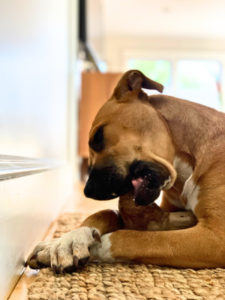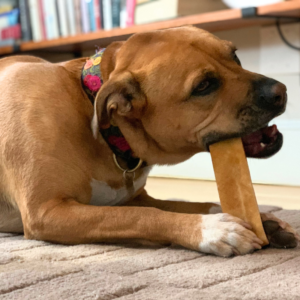Choosing chews is an important decision for a dog mom or dog dad. Dogs need the jaw exercise and stimulation, and pet parents need to keep their pups healthy and occupied. So as a dog parent, what do you need to consider when ‘chewsing’? Turns out, a lot! Let’s break it down into the types of safe bones and chews, discuss raw bones v. cooked bones, dental benefits, how to pick the right size for your dog, and also look at chew toys.
Recreational Bones
Recreational bones are big bones from the femurs and joints of very large mammals, like bison and steer. Femurs from steer are usually cut down to various lengths of marrow bones, but we do carry whole lamb femurs. Recreational bones are meant for stimulation, fun, and dental care. Our most popular include raw knuckle bones and marrow bones in 2inch, 4inch and 6inch. Dogs take to them naturally, and will happily gnaw on them for hours. Anything your dog safely chews on for an extended period of time will provide stress relief, stimulation and needed exercise for their jaws. But this kind of raw recreational bone also provide loads of dental benefits which we’ll discuss in a moment.
Antlers
Antlers, basically just bones that grow out of the head of large mammals, are another popular recreational bone. Antlers also have marrow, but it’s hard, as opposed to the soft and scoopable marrow you find in marrow bones. Antlers are naturally shed in the wild typically by elk, moose or deer, and then harvested, cleaned and cut to size. You’ll typically find them either whole or split. Split antlers have their marrow showing, which makes them a little softer to chew, and a little more accessible to dogs who have never tried them before. From hardest to softest, it’s Elk, followed by deer and then moose. All antlers are extremely hard though, and here’s what may surprise you. Antlers should be given only to gentle chewers. Aggressive chewers will use all their jaw power to try to get through an antler, and their teeth will give before the antler does, which leads to fractures – so only give antlers to your dog if you know they will chew it gently.
Raw v. Cooked Recreational Bones
Choose raw bones from a reputable source. Cooking by roasting or steaming changes the chemical structure, and causes the bones to become brittle, which means they can break easily and when they do they can be sharp, and not safe at all to chew on. Even chunks of bone that are not sharp can cause compactions if swallowed. Cooked bones are not appropriate for aggressive chewers at all, and we generally don’t recommend them. Roasted bones, like rib bones or shanks, are only appropriate for small, gentle chewers.
Dental Benefits of Raw Recreational Bones
A big raw bone will entice your dog to chew for a long time, and all the while they are scraping tartar and stimulating their gums. The raw meat creates an acidic saliva pH, which helps to prevent tartar. Plus, the live enzymes on the tissue adhering to the bone support healthy bacteria in the mouth. The dental benefits of chewing a safe raw meaty bone is second only to brushing.
Choosing the Right Size Bone
Remember this rule of thumb: only offer your dog a bone at least the size of their head, so there’s no way they can swallow it whole. For bones, stick with big bones, like femurs and knuckles. For chews, look for ones that at least twice as long as their head is wide. Always monitor your dog when they are chewing. Don’t let them sneak away to a far corner of the house or yard where you can’t see them, or something might happen and you won’t be able to help. Throw the bone or chew away when it’s worn down to a small size. If your dog is able to break off pieces of a bone, throw it away as well. There’s no danger in choosing too large a bone. If you are concerned about your dog ingesting too many calories, scoop the marrow out of the bone and replace with an alterantive and re-freeze so it hardens. Good alternatives are canned pumpkin, mashed chickpeas or a mix of yogurt, peanut butter and banana are all good options.
Edible Bones
Edible bones on the other hand are made to be chewed up and eaten – they are 100% consumable. Edible bones and chews are smaller and softer than recreational bones. Raw edible bones, like chicken backs, duck necks, and turkey necks contain lots of cartilage and soft bones that when served raw can be safely munched, swallowed, and digested. In addition to dental benefits these ‘parts’ provide lots of nutrients, protein and calories that can balance a homemade diet or replace a meal for a commercial diet.
Edible Chews
Look for chews that will take a long time before your dog (or the chew) give up. Our number one long-lasting chew is a beef cheek. They look like rawhide, but they are not hide at all. Beef cheeks are just what they sound like they are: specifically, the cheek muscle from a cow. The best beef cheeks are slow-roasted and dried without chemicals to produce a very sturdy roll, and they come in sizes appropriate for small or large dogs. Depending on the size of your dog and their style of chewing, a beef cheek can last days or even weeks!
Another great one to look for is a hard cheese chew. These tasty snacks are made from natural fermented cheese that hardens like cement. Cheese chews can definitely outlast a vigorous chew session for most dogs.
Chances are you know about bully sticks, our most popular edible chew. Depending on your dog’s size and chewing style, bullies can provide hours of safe, healthy chewing. There’s very little chance of waste – dogs are naturally drawn to the smell and flavor – but the cost may mean that bullies are a once-in-a-while treat. Bargain bags (multi-packs in 6 inch and 12 inch lengths) are the way to go.
Collagen sticks, braids and rings make great options. Collagen is dried and shaped, and sometimes coated with a flavor like pork or cheese. Collagen delivers extra health benefits for the skin and digestive tract.
The ribbed texture of dried beef or bison trachea delivers natural dental benefits by scraping tartar. Plus it’s packed with chondroitin, which provides powerful joint and cartilage support.
Looking for something different that’s fully edible and very hard to get through? Nothin’ to Hide pulverized dried collagen chews provide all the benefits of collagen sticks in a fun bone shape and a texture your dog might enjoy better than a stick or ring. Himalaya Unhide Chews somehow tranform just three ingredients (antler powder, cheese and vinegar) into a unique longlasting chew with a raised bumpy surface that pushes against the gums.
Always Check the Source
Avoid chews or bones without labels. Without a label, you won’t know which country, or even which animal is the source. Food safety standards and processing methods vary widely across countries, regions and also across companies. Choose products from the USA first. Argentina or Brazil, with their massive acres of open grazing land, export chews from grass-fed and free-range cattle, so we consider these countries a safe source as long as you choose a reputable brand.
Chew Toys
 Toys designed for chewing will last longer the longest of all chew options, and they will definitely save on your wallet while providing fun and stimulation.
Toys designed for chewing will last longer the longest of all chew options, and they will definitely save on your wallet while providing fun and stimulation.
Wood Chews
Try a Gorilla Chew made from java wood, or a Canophera Wood Stick made from coffee wood. They are tough, but softer than bones and antlers, so easier on the teeth. Dogs love sticks, so it’s there’s a natural attraction. Canophera’s Wood Chew + Coco incorporates coconut fiber rope knotted to the wood, which means multiple textures (fun!) and multiple dental benefits. The coco fiber has a flossing impact and its size and flexibility allows reaching teeth that wouldn’t otherwise get contact with a chew.
Nylon Chew Toys
Benebone flavor-infused nylon chews pack a ton of flavor (bacon ranks #1) into a variety of enticing shapes designed for maximum fun. Your dog can grasp the new Ring shape by their front paws, and hold it steady while they chew. Fill the bonus pocket with peanut butter or any tasty spread, and freeze for a special pop of fun. Insert a bully stick into the Benebone Pawplex, and your bullies will last longer – it’s basically a chew-extension toy.
Rope Chew Toys
Both Good Karma & Wild Meadow Farm rope toys provide flossing between the teeth as your dog chews on the 100% cotton rope fibers. Soak a rope toy in water (or broth) and freeze it to make it tougher to get through. Eventually the rope unravels – don’t worry, that’s part of the plan. Just trim & toss any loose threads so your dog won’t eat them. Rope toys provide the closest thing to flossing your dog will ever get excited about.
Stuffable Chew Toys
Fillable cavity toys double as a chew toy. Your dog will inevitably chew on the toy as they free the filling you’ve packed inside. We love cavity toys by SodaPup, Project Hive and West Paw as well as Kong. If you you have a heavy chewer, try an Extreme Kong. Black rubber is stronger than the red (the dyes in the red rubber make it more porous).

